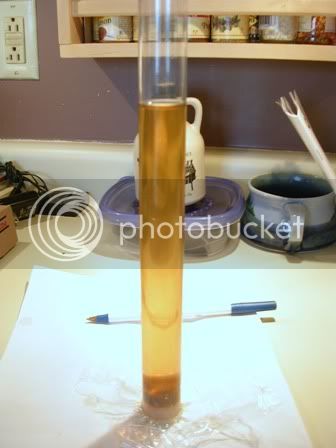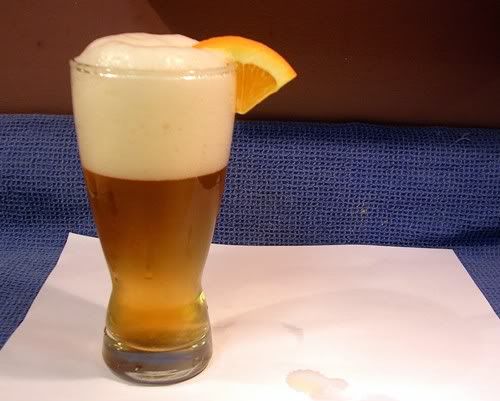sfbayjay
Active Member
Hi all,
Just brewed up a Belgian Wit yesterday, using a recipe that I shamelessly stole from BierMuncher in this thread:
https://www.homebrewtalk.com/f14/just-another-brew-day-pics-99893/
I adapted the AG recipe to a PM for a 5.5 gallon batch. Near the end of the boil, I added a slurry of flour and water as described in BierMuncher's thread. Everything about the brewday went well -- hit OG on the nose (1.049), pitched at 74* F, and have lots of CO2 this morning.
Here's the question. I left my OG sample in the test jar overnight. This morning, once trub had settled, I have a crystal clear wort (see image)

Color is pretty good, and smells great. But I thought the flour addition would give this some residual "haze." Perhaps things will be different post ferment? I pitched rehydrated Safale S-33 (didn't have any Wit yeast on-hand), and I'm fermenting at about 70* to try and coax out some of it's purportedly "fruity" characteristics.
Am I destined to have a crystal clear wit? Also -- forgive n00b question, but is it customary to poiur the yeast into the glass with a Witbier? How about if the yeast isn't truely Wit yeast?
Thanks for any input!
Just brewed up a Belgian Wit yesterday, using a recipe that I shamelessly stole from BierMuncher in this thread:
https://www.homebrewtalk.com/f14/just-another-brew-day-pics-99893/
I adapted the AG recipe to a PM for a 5.5 gallon batch. Near the end of the boil, I added a slurry of flour and water as described in BierMuncher's thread. Everything about the brewday went well -- hit OG on the nose (1.049), pitched at 74* F, and have lots of CO2 this morning.
Here's the question. I left my OG sample in the test jar overnight. This morning, once trub had settled, I have a crystal clear wort (see image)

Color is pretty good, and smells great. But I thought the flour addition would give this some residual "haze." Perhaps things will be different post ferment? I pitched rehydrated Safale S-33 (didn't have any Wit yeast on-hand), and I'm fermenting at about 70* to try and coax out some of it's purportedly "fruity" characteristics.
Am I destined to have a crystal clear wit? Also -- forgive n00b question, but is it customary to poiur the yeast into the glass with a Witbier? How about if the yeast isn't truely Wit yeast?
Thanks for any input!





